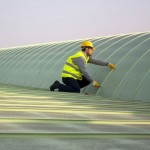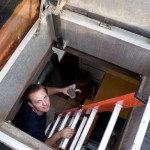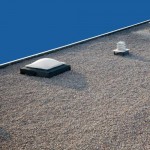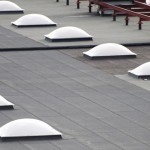Rooftop Fall Hazards: The Most Common Scenarios
 Rooftops are among the most common elevated areas where general industry work is performed. But they are also one of the most common areas where injuries or deaths occur as a result of a fall.
Rooftops are among the most common elevated areas where general industry work is performed. But they are also one of the most common areas where injuries or deaths occur as a result of a fall.
The types of work performed on rooftops is wide-ranging. It isn’t just limited to roofing contractors. School janitors may need to venture up to retrieve a lost soccer ball. Office maintenance or physical plant personnel may need to go up to clean out the gutters, or to remove snow in winter.HVAC service people may need to repair heaters or air conditioners, or to provide vent cleaning. Security specialists may need to install or service surveillance cameras or other security equipment. Window washers often use the roof as their “step-off point” for window washing on high rises.
To ensure the safety of your personnel, you should begin by doing an inspection of the roof to identify fall hazards. Make sure these hazards are clearly marked, and that workers are aware of them. Every roof is different, but the more hazards you identify at the beginning of the job, the easier it will be to provide fall protection, comply with OSHA requirements, and prevent injuries.
Hazards Around Access Points
 To begin with, look at the access points where people will access the roof.
To begin with, look at the access points where people will access the roof.
- Hatches may be potential fall hazards if left open during work. They may also be hazards if the hatch itself is close to the edge.
- Walk-out doors may have trip hazards around them, such as doorstop catches that are embedded at foot level.
- Exterior ladders and stairs may be in need of repair. Check to see that ladders and stairs are in good working order, rust-free, and securely attached to the wall.
- If workers is performed at night, look for poorly-lit areas where darkness or shadows may hide edges or trip hazards. Use auxiliary lighting if needed.
Hazards Around Roof Edges
Check the following areas near edges:
- Unprotected edges.
- Edges surrounded by parapets that are shorter than 42 inches.
- Ledges or adjacent areas where the walking level drops off more than four feet.
Please note that if workers will be working or walking within 15 feet of an edge, you are required to have a temporary guardrail there, to comply with OSHA regulations. Even if there is a permanent guardrail along the edge, you should check it for damage before a job begins, and also check to see if you need to install a toeboard to prevent tools from being dropped or kicked over the edge.
Hazards Around Walking Areas
When inspecting a roof area, you should identify the safest paths for people to walk, point them out to workers, and direct them to use those paths. Don’t assume that they will automatically identify or use the safest paths themselves.
Given a free choice, people will often use the shortest path to get across the surface, even if that path is not the safest path. For example, a less-safety-conscious worker might choose to walk up and over a triangular, slanted, corrugated tin section, instead of walking around these areas on the more level parts of the roof. If they slip while going over the slanted area, it could result in an injury or worse.
Make sure that safe walking areas are clearly marked, and inspect them for trip hazards. Also, inspect the surface for uneven areas, roof ribs, or loose or uneven seams.
Rooftop Equipment Hazards
You should inspect any rooftop equipment to see if it could cause a fall. Smaller equipment like pipes, vent chimneys, lights, sensors, or surveillance cameras may pose a trip hazard.
Larger units such as air conditioners, heaters, or vent fans may pose a fall hazard if they are higher than six feet, especially if workers must climb on top of them. There is also the possibility that workers could fall into or through large pieces of equipment while servicing them.
Skylights and Other Openings
 Any opening in your rooftop can be a potential fall hazard. Often, the glass cover of a skylight or the screen cover of a smoke vent is not strong enough to support a person’s weight. A worker could easily fall through the cover if they stand on a skylight or smoke vent, or trip and fall against it. Also, as previously mentioned, an open hatch is one of the more dangerous fall hazards.
Any opening in your rooftop can be a potential fall hazard. Often, the glass cover of a skylight or the screen cover of a smoke vent is not strong enough to support a person’s weight. A worker could easily fall through the cover if they stand on a skylight or smoke vent, or trip and fall against it. Also, as previously mentioned, an open hatch is one of the more dangerous fall hazards.
Other Fall Hazards
There are other things to consider when looking for fall hazards on a rooftop. You should, of course, look for slippery spots caused by recent rain, sleet, or snow, and mark these areas so that workers can see and avoid them, or at least proceed with caution.
Also, you should determine if any tools, chemicals (i.e. paint, varnish, or cleaning fluid), or other materials used by workers may cause them to trip or slip. Every area is different and will have its own unique characteristics and potential hazards.
IMPORTANT NOTE: This is the first in a series of articles about rooftop safety. In the weeks to come, we will post more articles about fall protection equipment for rooftop workers, and about using guardrails, skylight covers, and other safety solutions. Stay tuned for more!

